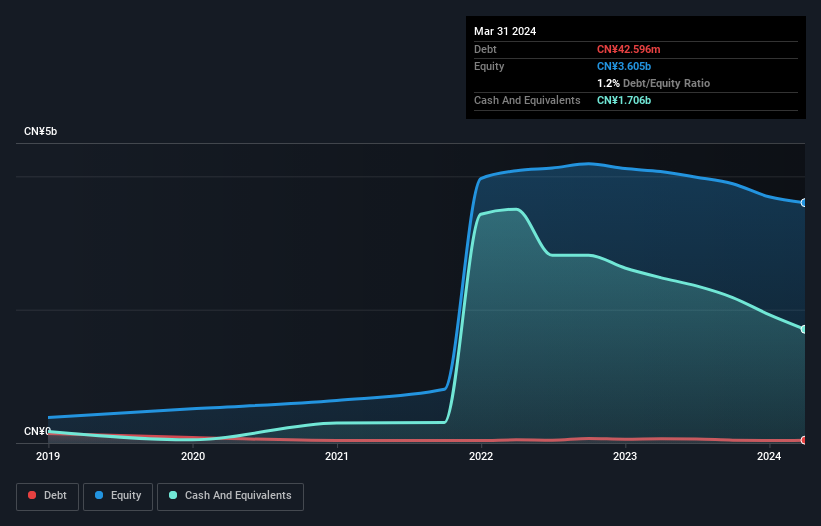
Howard Marks put it nicely when he said that, rather than worrying about share price volatility, 'The possibility of permanent loss is the risk I worry about... and every practical investor I know worries about.' So it might be obvious that you need to consider debt, when you think about how risky any given stock is, because too much debt can sink a company. We can see that Dosilicon Co., Ltd. (SHSE:688110) does use debt in its business. But the real question is whether this debt is making the company risky.
Why Does Debt Bring Risk?
Debt and other liabilities become risky for a business when it cannot easily fulfill those obligations, either with free cash flow or by raising capital at an attractive price. Ultimately, if the company can't fulfill its legal obligations to repay debt, shareholders could walk away with nothing. However, a more common (but still painful) scenario is that it has to raise new equity capital at a low price, thus permanently diluting shareholders. By replacing dilution, though, debt can be an extremely good tool for businesses that need capital to invest in growth at high rates of return. When we think about a company's use of debt, we first look at cash and debt together.
View our latest analysis for Dosilicon
What Is Dosilicon's Net Debt?
You can click the graphic below for the historical numbers, but it shows that Dosilicon had CN¥42.6m of debt in March 2024, down from CN¥63.5m, one year before. However, its balance sheet shows it holds CN¥1.71b in cash, so it actually has CN¥1.66b net cash.

A Look At Dosilicon's Liabilities
The latest balance sheet data shows that Dosilicon had liabilities of CN¥122.1m due within a year, and liabilities of CN¥24.6m falling due after that. Offsetting this, it had CN¥1.71b in cash and CN¥60.0m in receivables that were due within 12 months. So it actually has CN¥1.62b more liquid assets than total liabilities.
It's good to see that Dosilicon has plenty of liquidity on its balance sheet, suggesting conservative management of liabilities. Because it has plenty of assets, it is unlikely to have trouble with its lenders. Succinctly put, Dosilicon boasts net cash, so it's fair to say it does not have a heavy debt load! There's no doubt that we learn most about debt from the balance sheet. But it is Dosilicon's earnings that will influence how the balance sheet holds up in the future. So when considering debt, it's definitely worth looking at the earnings trend. Click here for an interactive snapshot.
In the last year Dosilicon had a loss before interest and tax, and actually shrunk its revenue by 45%, to CN¥513m. That makes us nervous, to say the least.
So How Risky Is Dosilicon?
We have no doubt that loss making companies are, in general, riskier than profitable ones. And in the last year Dosilicon had an earnings before interest and tax (EBIT) loss, truth be told. And over the same period it saw negative free cash outflow of CN¥357m and booked a CN¥316m accounting loss. With only CN¥1.66b on the balance sheet, it would appear that its going to need to raise capital again soon. Even though its balance sheet seems sufficiently liquid, debt always makes us a little nervous if a company doesn't produce free cash flow regularly. There's no doubt that we learn most about debt from the balance sheet. However, not all investment risk resides within the balance sheet - far from it. We've identified 1 warning sign with Dosilicon , and understanding them should be part of your investment process.
At the end of the day, it's often better to focus on companies that are free from net debt. You can access our special list of such companies (all with a track record of profit growth). It's free.
New: Manage All Your Stock Portfolios in One Place
We've created the ultimate portfolio companion for stock investors, and it's free.
• Connect an unlimited number of Portfolios and see your total in one currency
• Be alerted to new Warning Signs or Risks via email or mobile
• Track the Fair Value of your stocks
Have feedback on this article? Concerned about the content? Get in touch with us directly. Alternatively, email editorial-team (at) simplywallst.com.
This article by Simply Wall St is general in nature. We provide commentary based on historical data and analyst forecasts only using an unbiased methodology and our articles are not intended to be financial advice. It does not constitute a recommendation to buy or sell any stock, and does not take account of your objectives, or your financial situation. We aim to bring you long-term focused analysis driven by fundamental data. Note that our analysis may not factor in the latest price-sensitive company announcements or qualitative material. Simply Wall St has no position in any stocks mentioned.
Have feedback on this article? Concerned about the content? Get in touch with us directly. Alternatively, email editorial-team@simplywallst.com
About SHSE:688110
Dosilicon
A fabless memory solution company, designs, produces, and sells memory chips worldwide.
Flawless balance sheet with high growth potential.
Market Insights
Community Narratives



